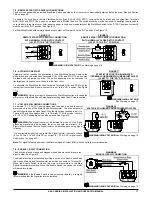
KBAC SERIES INSTALLATION AND OPERATION MANUAL
5
2 – SAFETY WARNINGS
Definition of Safety Warning Symbols
Electrical Hazard Warning Symbol:
Failure to observe this warning could result in electrical shock or electrocution.
Operational Hazard Warning Symbol:
Failure to observe this warning could result in serious injury or death.
SAFETY WARNING! – PLEASE READ CAREFULLY!
This product must be installed and serviced by a qualified technician, electrician, or electrical maintenance person familiar with its operation
and the hazards involved. Proper installation, which includes electrical connections, fusing or other current protection, and grounding, can
reduce the chance of electrical shocks, and/or fires, in this product or products used with this product, such as electric motors, switches,
coils, solenoids, and/or relays. Do not use this drive in an explosion-proof application. Eye protection must be worn and insulated adjustment
tools must be used when working with drive under power. This product is constructed of materials (plastics, metals, carbon, silicon, etc.)
which may be a potential hazard. Proper shielding, grounding, and filtering of this product can reduce the emission of radio frequency
interference (RFI) which may adversely affect sensitive electronic equipment. It is the responsibility of the equipment manufacturer and
individual installer to supply this Safety Warning to the ultimate end user of this product. (SW 8/2012)
The control contains electronic Start/Stop circuits, which can be used to start and stop the control. However, these circuits are never to be
used as safety disconnects since they are not fail-safe. Disconnect the input power for this purpose. Be sure to read and follow all
instructions carefully. Fire and/or electrocution can result due to improper use of this product.
This product complies with all CE directives pertinent at the time of manufacture. Contact Technical support for Declaration of
Conformity. Installation of a CE approved RFI filter is required. See RFI Filters & Chokes Selection Guide D-321 (Part No. A42027) for
selection of filters that meet the Industrial or Residential Standard. Additional shielded cable and/or AC Line cables may be required along
with a signal isolator.
3 – IMPORTANT APPLICATION INFORMATION
3.1 – MOTOR WITH EXTERNAL FAN COOLING
Most totally enclosed fan-cooled (TEFC) and open ventilated 3-phase AC induction motors will overheat if used beyond a limited speed range
at full torque. Therefore, it is necessary to reduce motor load as speed is decreased.
Note:
Some fan-cooled motors can be used over a wider speed range. Consult the motor manufacturer for details.
CAUTION!
1.
Some motors have low speed characteristics which cause overheating and winding failure under light load or no-load
conditions. If the motor is operated in this manner for an extended period of time, it is recommended that the unloaded motor current be
checked from 2 – 15 Hz (60 – 450 RPM) to ensure motor current does not exceed the nameplate rating. Do not use the motor if the motor
current exceeds the nameplate rating.
2.
It is recommended that the drive be used with Inverter Duty or TENV motors. Inverter duty and most
totally enclosed non-ventilated (TENV) motors can provide full rated torque over an extended speed range without overheating. See Figure 2.
3.
If external fan cooling is provided, open ventilated motors can also achieve an extended speed range at full rated torque. A box fan or
blower with a minimum of 100 CFM per HP is recommended. Mount the fan or blower so the motor is surrounded by the airflow. See Figure 3.
FIGURE 2
MAXIMUM ALLOWED MOTOR TORQUE VS. SPEED
FIGURE 3
OPEN VENTILATED MOTOR WITH EXTERNAL FAN COOLING
TEFC and Open Ventilated
Inverter Duty
and TENV
Motors
Fan Cooled
Motors
3.2 – Electronic Motor Overload Protection
The drive contains Modified I
2
t Overload Protection (UL approved as an overload protector for motors). Part of this function consists of a
Current Limit (CL) circuit, which limits the drive current to a preset level of 160% of the rated drive current. The CL Trimpot is used to
recalibrate the drive current from 60% thru 200%. The Power Start™ circuit provides an overshoot function that allows most motors to develop
more than 200% of starting torque and breakdown torque.
Standard I
2
t is undesirable because it causes nuisance tripping. It allows a very high motor current to develop and will turn the drive off after a
short period of time. The RMS Current Limit Circuit, which includes I
2
t plus an I•t timing circuit (as described in the paragraph below), avoids
this nuisance tripping while providing maximum motor protection.
If the motor is overloaded to 120% of full load (75% of the CL setting), the I•t Timer starts. If the motor continues to be overloaded at the 120%
level, the timer will shut down the drive after 30 minutes. If the motor is overloaded to 160% of full load, the drive will trip in 6 seconds.






































